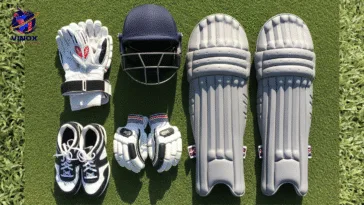Cricket in the Olympics: A Historic Comeback for the Gentleman’s Game
Cricket in the Olympics has long been a dream for fans and players around the globe. After over a century of absence, this beloved sport is finally poised to make a grand return to the Olympic arena. With its inclusion in the Los Angeles 2028 Olympics, cricket is set to captivate a new generation of global sports fans. But how did this journey unfold, and what does it mean for the future of cricket? Let’s explore the full picture.
ORDER PREMIUM CRICKET BAT BY VINOX SPORTS
History of Cricket in the Olympics
Cricket’s First Appearance at the Olympics
Cricket was first featured in the 1900 Paris Olympics, making its Olympic debut in a single match between Great Britain and France. Ironically, the French team was largely composed of British expatriates. The match lasted two days, with Great Britain taking home the gold medal. Despite this historic event, cricket did not return in any future Olympic Games—until now.
Why Cricket Was Absent for Over a Century
There are several reasons why cricket in the Olympics did not continue:
-
Lack of global reach at the time
-
Difficulty in scheduling due to the sport’s long match formats
-
Absence of a unified governing body pushing for Olympic inclusion
However, with the rise of T20 cricket, things have drastically changed.
The Road to Olympic Inclusion
The Role of ICC and National Boards
The International Cricket Council (ICC) played a pivotal role in lobbying for cricket’s inclusion in the Olympics. National boards like the Board of Control for Cricket in India (BCCI), which were previously hesitant, began to support the move, seeing the massive global exposure the Olympics could provide.
Why T20 Format Was Chosen
The T20 format—short, exciting, and fast-paced—was key to cricket’s Olympic approval. Unlike Test matches or ODIs, a T20 match can be wrapped up in just 3 hours, making it ideal for the Olympics schedule.
Cricket in Los Angeles 2028: What to Expect
Participating Teams and Format
The LA 2028 Olympic cricket event will feature 6 men’s and 6 women’s teams, including powerhouses like India, Australia, England, and emerging teams from the USA and Europe. The tournament will follow a round-robin and knockout format, ensuring maximum thrill in a compact window.
Venues and Infrastructure
Cricket in the Olympics will make use of dedicated cricket stadiums and multi-sport venues adapted for the event. The USA has already begun developing infrastructure in cities like Dallas, Florida, and Los Angeles to support the sport’s growth.
Impact of Olympic Cricket on the Global Stage
A Boost for Associate Nations
The inclusion of cricket in the Olympics provides a golden opportunity for associate nations like Nepal, USA, Germany, and Namibia to gain international visibility. Government funding tied to Olympic sports will help these nations invest in grassroots development.
Increased Investment and Sponsorship
Cricket’s Olympic debut is expected to attract major global sponsors, expanding the sport’s commercial appeal beyond traditional markets. Brands associated with both the Olympics and cricket—like Nike, Coca-Cola, and Visa—are preparing to jump on board.
Cricket’s Popularity: Fueling Olympic Inclusion

Massive Global Fan Base
With over 2.5 billion fans, primarily in Asia, the UK, Australia, and parts of Africa, cricket is one of the most-watched sports worldwide. The success of T20 leagues like the IPL and BBL has shown how marketable and entertaining the shorter format is.
Cricket in the USA: A Growing Market
The USA is set to be a major focus area for Olympic cricket. With a large South Asian diaspora and increasing youth interest, the timing couldn’t be better. The launch of Major League Cricket (MLC) in 2023 further laid the groundwork for local talent and infrastructure.
Challenges Cricket Faces in the Olympics
Scheduling Conflicts with Major Tournaments
One of the biggest challenges is aligning Olympic cricket with other major events like the IPL, The Hundred, and T20 World Cups. Player availability may become a concern, especially with tight international schedules.
Maintaining Competitive Balance
With traditional giants like India and Australia dominating the game, there is concern that Olympic cricket might become one-sided. However, ICC has plans to rotate qualification slots and promote emerging nations through Olympic qualifiers.
Reactions from the Cricketing World
Players’ Perspective
Top cricketers like Virat Kohli, Meg Lanning, and Jos Buttler have expressed excitement about representing their nations at the Olympics. For them, winning an Olympic medal is considered the pinnacle of national pride.
Fans’ Reactions
Social media has been abuzz with hashtags like #CricketInOlympics and #RoadToLA2028, with many hoping to see cricket become a permanent fixture in future Olympic Games.
Future of Cricket in the Olympics
Sustainable Inclusion
If cricket’s Olympic debut in 2028 proves successful, there are already talks of including it in Brisbane 2032 and beyond. The ICC is working closely with Olympic committees to ensure that cricket not only debuts but thrives.
Potential Expansion of Teams and Formats
In future editions, we might see more teams participating, possibly expanding from 6 to 10. Additionally, new formats like T10 cricket could also make their way into the Olympics, appealing to younger audiences and shorter attention spans.
Conclusion: A New Era for Cricket
The reintroduction of cricket in the Olympics marks a turning point for the sport. It opens up new horizons, promotes global outreach, and brings the game closer to being recognized as a truly international phenomenon. As we look ahead to Los Angeles 2028, cricket fans around the world have every reason to celebrate.





 No products in the cart.
No products in the cart.